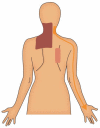A Targeted Approach to Post-Mastectomy Pain and Persistent Pain following Breast Cancer Treatment
- PMID: 34680339
- PMCID: PMC8534110
- DOI: 10.3390/cancers13205191
A Targeted Approach to Post-Mastectomy Pain and Persistent Pain following Breast Cancer Treatment
Abstract
Persistent pain following treatment for breast cancer is common and often imprecisely labeled as post-mastectomy pain syndrome (PMPS). PMPS is a disorder with multiple potential underlying causes including intercostobrachial nerve injury, intercostal neuromas, phantom breast pain, and pectoralis minor syndrome. Adding further complexity to the issue are various musculoskeletal pain syndromes including cervical radiculopathy, shoulder impingement syndrome, frozen shoulder, and myofascial pain that may occur concurrently and at times overlap with PMPS. These overlapping pain syndromes may be difficult to separate from one another, but precise diagnosis is essential, as treatment for each pain generator may be distinct. The purpose of this review is to clearly outline different pain sources based on anatomic location that commonly occur following treatment for breast cancer, and to provide tailored and evidence-based recommendations for the evaluation and treatment of each disorder.
Keywords: cancer rehabilitation; persistent pain in breast cancer; post-mastectomy pain; post-mastectomy pain syndrome.
Conflict of interest statement
The authors declare no conflict of interest.
Figures


References
-
- Cancer Fact Sheets: 39 All Cancers Fact Sheet. [(accessed on 28 June 2021)]. Available online: https://gco.iarc.fr/today/data/factsheets/cancers/39-All-cancers-fact-sh....
-
- American Cancer Society . Breast Cancer Facts & Figures 2019–2020. American Cancer Society; Atlanta, GA, USA: 2020.
-
- How Common Is Breast Cancer? Breast Cancer Statistics. [(accessed on 29 June 2021)]. Available online: https://www.cancer.org/cancer/breast-cancer/about/how-common-is-breast-c....
-
- Treede R.-D., Rief W., Barke A., Aziz Q., Bennett M.I., Benoliel R., Cohen M., Evers S., Finnerup N.B., First M.B., et al. Chronic Pain as a Symptom or a Disease: The IASP Classification of Chronic Pain for the International Classification of Diseases (ICD-11) Pain. 2019;160:19–27. doi: 10.1097/j.pain.0000000000001384. - DOI - PubMed
Publication types
LinkOut - more resources
Full Text Sources

